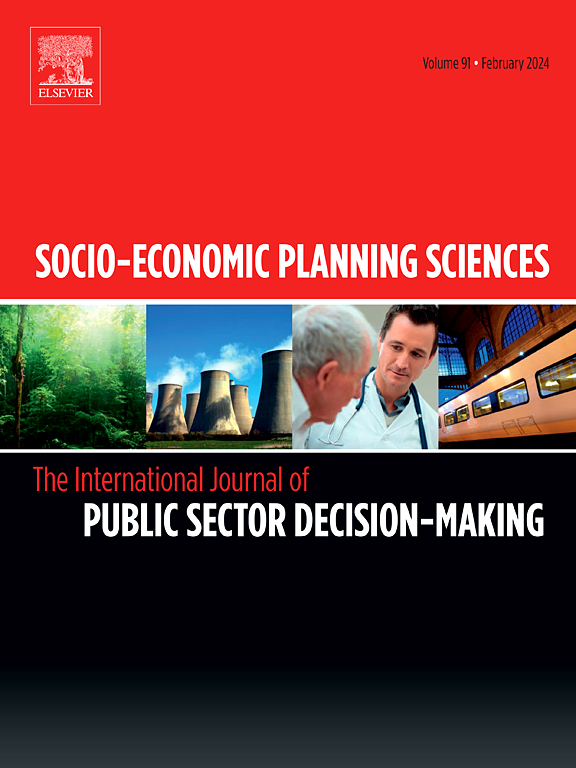胡萝卜还是大棒?如何有效管理农村非规模化养殖废弃物
IF 5.4
2区 经济学
Q1 ECONOMICS
引用次数: 0
摘要
补贴(胡萝卜)和监管(大棒)是提高农村非规模化农业废弃物集中第三方治理模式运行稳定性和效率的有效途径。然而,这些方法适用的具体场景还需要进一步探索,特别是在考虑区域生态承载力、养殖规模和农民地理分布变化等因素的情况下。从这一特定视角出发,本文构建了一个进化博弈模型来反映农民、第三方企业和政府之间的互动关系。在此模型的基础上,本文首先考察了三方战略选择的影响因素及其演化路径。其次,将模型与仿真分析结果相结合,解释了各方策略均衡解的稳定性条件。最后,根据不同地区的自然资源禀赋和农业生产实际情况,给出了不同调控策略和补贴方案的适用场景。研究结果表明:①在农业集中度低、农业规模小、政府参与监管成本高的地区,政府应给予农户收购补贴和第三方企业投资补贴,以吸引各类主体参与废弃物治理。②在农业集中度高、农业规模大、政府参与监管成本低的地区,政府应采取监管与补贴相结合的方式,促进第三方管理模式的稳定运行。③在鼓励农户遵守废弃物处理法规方面,补贴和监管两种策略(即胡萝卜加大棒)具有一定的替代作用。政府应根据农业集中度、生态承载力、运输成本等区域因素选择监管或补贴策略。④在所有情景下,政府参与第三方废物集中处理的补贴和监管总成本均低于无管制废物排放造成的环境损失和政治绩效损失。本文的研究结果为政府参与环境治理提供了理论支持,同时也为企业提供了投资参考。本文章由计算机程序翻译,如有差异,请以英文原文为准。
Carrot or stick? How to effectively manage non-scale farming waste in rural areas
Subsidies (carrot) and supervision (stick) are effective ways to enhance the operational stability and efficiency of the centralized third-party governance model for non-scale farming waste in rural areas. However, the specific scenarios in which these methods are applicable still require further exploration, particularly when considering factors such as regional ecological carrying capacity, farming scale, and variations in the geographical distribution of farmers. From that specific perspective, this paper constructs an evolutionary game model to reflect the interaction relationships among farmers, third-party enterprises, and the government. Based on this model, this paper first investigates the influencing factors and evolutionary paths of strategy selection by the three parties. Second, by combining the model with the simulation analysis results, the authors explain the stability conditions of the equilibrium solutions for each party's strategy. Finally, according to the natural resource endowment and actual agricultural production situations in different regions, this paper provides applicable scenarios for different regulatory strategies and subsidy schemes. The results of this paper indicate that: ① in regions characterized by a low concentration of farming, small farming scale, and high costs of government involvement in supervision, the government should give acquisition subsidies to farmers and investment subsidies for the third-party enterprise, so as to attract various entities to participate in waste management. ② In regions characterized by high farming concentration, large farming scale, and low costs of government involvement in supervision, the government should adopt a combination of supervision and subsidies, so as to promote the stable operation of the third-party management model. ③ In terms of encouraging farmers to comply with waste disposal regulations, the two strategies of subsidy and supervision (i.e., carrot and stick) have a certain degree of substitution. The government should choose supervision or subsidy strategies according to regional factors, such as the concentration of farming, the ecological carrying capacity, and transportation costs. ④ In all scenarios, the total cost of subsidies and supervision for government participation in third-party centralized waste treatment is lower than the environmental losses and political performance losses caused by unregulated waste discharge. The results of this paper provide theoretical support for government participation in environmental governance, while also providing an investment reference for enterprises.
求助全文
通过发布文献求助,成功后即可免费获取论文全文。
去求助
来源期刊

Socio-economic Planning Sciences
OPERATIONS RESEARCH & MANAGEMENT SCIENCE-
CiteScore
9.40
自引率
13.10%
发文量
294
审稿时长
58 days
期刊介绍:
Studies directed toward the more effective utilization of existing resources, e.g. mathematical programming models of health care delivery systems with relevance to more effective program design; systems analysis of fire outbreaks and its relevance to the location of fire stations; statistical analysis of the efficiency of a developing country economy or industry.
Studies relating to the interaction of various segments of society and technology, e.g. the effects of government health policies on the utilization and design of hospital facilities; the relationship between housing density and the demands on public transportation or other service facilities: patterns and implications of urban development and air or water pollution.
Studies devoted to the anticipations of and response to future needs for social, health and other human services, e.g. the relationship between industrial growth and the development of educational resources in affected areas; investigation of future demands for material and child health resources in a developing country; design of effective recycling in an urban setting.
 求助内容:
求助内容: 应助结果提醒方式:
应助结果提醒方式:


